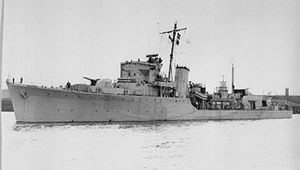Name HMS Zetland Ordered 20 December 1939 Commissioned 27 June 1942 Launched 7 March 1942 Draft 2.51 m | Namesake Zetland Hunt Laid down 2 October 1940 Construction started 2 October 1940 Length 85 m | |
 | ||
Out of service Loaned to the Royal Norwegian Navy in 1952Sold to them in July 1956 | ||
HMS Zetland was a Royal Navy Type II Hunt-class destroyer, named after the Zetland Hunt.
Contents
Built by Yarrow Shipbuilders, Glasgow and launched on 7 March 1942. She was commissioned on 27 June 1942 with the pennant number L59. Zetland was given to the Royal Norwegian Navy and commissioned as HNoMS Tromsø. She was sold for breaking up in 1965.
Construction
HMS Zetland was ordered from Yarrows on 20 December 1939, one of 16 Type II Hunt-class destroyers ordered from various shipbuilders on that date, (including two from Yarrows). The Hunts were meant to fill the Royal Navy's need for a large number of small destroyer-type vessels capable of both convoy escort and operations with the fleet. The Type II Hunts differed from the earlier ships in having increased beam in order to improve stability and carry the ships' originally intended armament.
Zetland was laid down at Yarrow's Scotstoun, Glasgow shipyard on 2 October 1940, was launched on 15 January 1942 and completed on 7 May 1942.
Zetland was 264 feet 3 inches (80.54 m) long between perpendiculars and 280 feet (85.34 m) overall. The ship's beam was 31 feet 6 inches (9.60 m) and draught 7 feet 9 inches (2.36 m). Displacement was 1,050 long tons (1,070 t) standard and 1,490 long tons (1,510 t) under full load. Two Admiralty boilers raising steam at 300 pounds per square inch (2,100 kPa) and 620 °F (327 °C) fed Parsons single-reduction geared steam turbines that drove two propeller shafts, generating 19,000 shaft horsepower (14,000 kW) at 380 rpm. This gave a speed of 27 knots (50 km/h; 31 mph). 277 long tons (281 t) of oil were carried, giving a design range of 2,560 nautical miles (4,740 km; 2,950 mi) (although in service use, this dropped to 1,550 nautical miles (2,870 km; 1,780 mi)).
The ship's main gun armament was six 4 inch (102 mm) QF Mk XVI dual purpose (anti-ship and anti-aircraft) guns in three twin mounts, with one mount forward and two aft. Additional close-in anti-aircraft armament was provided by a quadruple 2-pounder "pom-pom" mount and two single Oerlikon 20 mm cannon mounted in the bridge wings. Power-operated twin 20 mm Oerlikon mounts replaced the single Oerlikons during the war. Up to 110 depth charges could be carried. The ship had a complement of 168 officers and men.
Second World War service
During the Second World War, Zetland saw service in the Atlantic (1942–43), Malta Convoys (1942), north Africa (1942–43), Mediterranean (1943–44), Aegean (1944), Adriatic (1944) and Operation Dragoon, the landings in southern France in 1944.
Air Raid on Bari
Zetland was one of two Hunt-class destroyers that were damaged in the air raid on Bari on 2 December 1943. An ammunition ship was hit and exploded, spreading her cargo of mustard gas over the harbour and town. Zetland was near-missed by a German bomb, and subject to blast and fragment damage from the explosion of two nearby merchant ships. Zetland's sister ship, Bicester was damaged more seriously. Zetland towed Bicester to Taranto for repairs. There were so many mustard gas casualties that, on arrival in Taranto, the ships had to ask for assistance to enter the harbour as all navigating officers had their vision impaired by this chemical weapon.
Postwar service
Between June and October 1945 Zetland was in refit in Alexandria, before returning to the UK. On 20 April 1946 she paid off into reserve and was assigned to the Solent Division Royal Naval Volunteer Reserve (RNVR) as a drill ship. On 2 September 1954 she was lent to Norway. She was broken up in 1965 at Sarpsborg shipbreakers.
